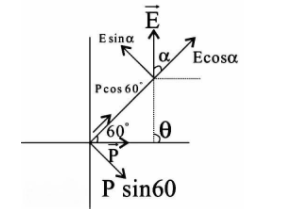Question
Question: The electric dipole is placed along the x-axis at the origin OF. A point P is at a distance of \(20{...
The electric dipole is placed along the x-axis at the origin OF. A point P is at a distance of 20 cm from this origin such that OP makes an angle 60∘ with the x - axis. If the electric field at P makes an angle θ with the x - axis, the value of θ would be
A. 3π
B. tan−123
C. 32π
D. 3π+tan−123
Solution
**Hint: **Resolve the electrical dipole and electric field in two components. Then find the electric field due to the dipole at the axial and equatorial point.
The electric field due to a dipole at an axial point is given by Eaxial=r32kp in the direction of the dipole.
The electric field due to a dipole at an equatorial point is given by Eeq=r3kp in the direction opposite to that of the dipole.
Here, p is the dipole moment, r is the distance of the point from the dipole and k=4πε01
.
Complete step by step answer
Let us first discuss an electric dipole. It is basically an electrostatic system of two equal and opposite point charges separated by a very small distance.
As given in the question that the electric dipole is placed along the x-axis at the origin O and a point P is at a distance of 20 cm from this origin such that OP makes an angle 60∘ with the x - axis. Now, if the electric field at P makes an angle θ with the x - axis, we have to calculate the value of θ .
A diagram is given which shows the case.
Let E be the magnitude of the electric field, α be the angle between the electric field and line OP and r=20cm be the distance OP.
Now, the electric dipole and the electric field vector are resolved into the two components.
We know that the electric field due to a dipole at an axial point is given by Eaxial=r32kp in the direction of the dipole.
For the axial point, the dipole moment has value pcos60∘ and the electric field component is Ecosα .
Therefore, according to the above expression we have

Ecosα=r32kpcos60∘ …..(i)
We also know that the electric field due to a dipole at an equatorial point is given by Eeq=r3kp in the direction opposite to that of the dipole.
For the equatorial point, the dipole moment has value psin60∘ and the electric field component is Esinα .
Therefore, according to the above expression we have
Esinα=r3kpsin60∘ …..(ii)
Now, dividing equation (ii) by (i) we have
tanα=2tan60∘=23
On simplifying we have
α=tan−123
Now, from the figure we have
θ=α+60∘=α+3π
On substituting the value of α we have the final answer as
θ=3π+tan−123
Hence, option D is correct.
Note: The formula used for the electric field due to a dipole in this question is only valid when the distance between the charges of the dipole is very small as compared to the distance between the centre of the dipole and the point where the electric field is to be calculated.
